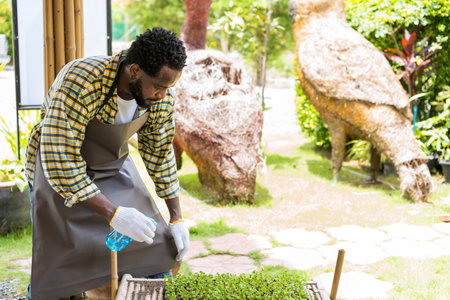Introduction to Pest Control Lingo
In the ever-changing landscape of American homes, gardens, and shared spaces, understanding pest control lingo is more than just a technicality—its an essential tool for creating healthy, vibrant environments. Whether you’re a homeowner determined to protect your sanctuary, a gardener nurturing blooms and harvests, or a property manager overseeing expansive grounds, knowing the right terms empowers you to make informed decisions. As eco-conscious approaches and traditional chemical solutions intertwine in the modern marketplace, fluency in pest control terminology helps you navigate product labels, professional recommendations, and DIY strategies with confidence. By demystifying these words and phrases, youll not only safeguard your surroundings but also cultivate peace of mind—knowing your choices reflect both personal well-being and environmental stewardship.
2. Essential Natural Pest Control Terms
When embracing eco-friendly and organic pest management, understanding the language of natural solutions is key. Below are essential buzzwords and phrases that shape how Americans approach DIY and sustainable pest control. These terms frequently appear in gardening, landscaping, and home care conversations across the U.S., reflecting a growing movement toward safer, greener environments.
Key Terms in Natural Pest Control
| Term | Description | Common Use in U.S. Context |
|---|---|---|
| Biological Control | The use of living organisms—such as beneficial insects or microbes—to manage pests. | Lacewings and ladybugs released in gardens to control aphids naturally. |
| Companion Planting | Strategically planting different species together to repel pests or attract beneficial insects. | Basil planted near tomatoes to deter hornworms; marigolds used as a border plant for nematode control. |
| Diatomaceous Earth (DE) | A natural powder made from fossilized algae that dehydrates and kills crawling insects. | Sprinkled around garden beds or inside homes to target ants, fleas, and bed bugs without chemicals. |
| Neem Oil | An organic extract from neem tree seeds used as a natural pesticide and fungicide. | Widely applied to vegetable gardens and ornamental plants for safe insect control. |
| Integrated Pest Management (IPM) | An ecosystem-based strategy combining multiple techniques for long-term pest prevention with minimal impact on health or environment. | Commonly adopted by schools, parks, and home gardeners across the U.S. for balanced pest solutions. |
| Beneficial Insects | Insects that prey on or parasitize pests, reducing their populations naturally. | Lacewings, ladybugs, and predatory wasps used in landscape design for natural balance. |
| Organic Certification | The official recognition that products or methods meet USDA standards for being grown or processed without synthetic chemicals. | Look for “OMRI Listed” products at garden centers when seeking approved organic pest controls. |
| Essential Oils (EOs) | Plant-derived oils such as peppermint, citronella, or eucalyptus used to repel pests naturally. | DIY sprays using EOs are popular for keeping mosquitoes and ants away from patios and entryways. |
Sustainable Strategies in Everyday Practice
The above terms are more than just jargon—they represent a commitment to beauty and biodiversity in American landscapes. Whether you’re nurturing a pollinator-friendly backyard or managing pests on an urban balcony, these concepts empower you to make environmentally conscious choices. As you explore further sections of this glossary, keep these foundational ideas in mind: they are the roots of healthy, thriving outdoor spaces across the country.
![]()
3. Chemical Pest Control Explained
Understanding Chemical Terms in American Pest Control
Chemical pest control relies on a wide variety of substances to manage unwanted insects, rodents, and weeds. In the United States, you’ll often encounter terms like “insecticide,” “herbicide,” “rodenticide,” and “fungicide” on product labels. Each refers to chemicals designed to target specific pests: insecticides for bugs, herbicides for plants or weeds, rodenticides for rodents, and fungicides for mold or fungi. It’s important to know these distinctions, as each product is formulated with unique active ingredients and application methods.
Key Definitions You Should Know
- Active Ingredient: The chemical component that actually kills or controls the pest. Always listed prominently on product labels.
- Residual: Indicates how long the chemical remains effective after application. Some products offer weeks of protection; others break down quickly.
- Broad-spectrum: Chemicals that affect a wide range of pests, not just one type. While convenient, they may also impact beneficial organisms.
- Selectivity: Some products are “selective,” meaning they only target certain pests and leave others unharmed—ideal for eco-conscious landscapes.
- EPA Registration: In the U.S., all chemical pest control products must be approved by the Environmental Protection Agency (EPA) for safety and efficacy.
Regulations and Safety Notes
The EPA regulates which chemical products can be sold in America, ensuring each has been tested for both effectiveness and safety to humans, pets, wildlife, and the environment. Always follow label directions—misuse can result in health hazards or environmental harm. Look for signal words such as “Caution,” “Warning,” or “Danger” on labels; these indicate the toxicity level. When using any chemical pest control method, personal protective equipment (PPE) like gloves or masks is often recommended. Responsible use not only protects your home but preserves the beauty and balance of American outdoor spaces.
4. Integrated Pest Management (IPM) Vocabulary
Integrated Pest Management, commonly known as IPM, is the artful blend of science and sustainability—a philosophy that mirrors the American spirit of innovation and respect for our landscapes. This holistic approach doesn’t just target pests; it nurtures balance, weaving together natural controls and selective intervention. Below, let’s stroll through a curated glossary of everyday IPM terms and see how they shape the landscape of sustainable pest management.
The Language of IPM: Key Terms Explained
| Term | Definition | Common Use in Everyday Conversation |
|---|---|---|
| Threshold Level | The pest population level at which action must be taken to prevent unacceptable damage. | “We don’t spray until pests hit the threshold.” |
| Biological Control | Using living organisms—like ladybugs or nematodes—to manage pests naturally. | “Let’s release some beneficial bugs instead of chemicals.” |
| Cultural Controls | Practices like crop rotation, proper watering, and sanitation to deter pests without direct intervention. | “Switching up our planting schedule is a smart cultural control.” |
| Mechanical Controls | Physical methods such as traps, barriers, or hand-picking pests from plants. | “We’re using row covers as a mechanical control.” |
| Chemical Controls | The selective use of pesticides as a last resort when other measures aren’t enough. | “Chemicals are our backup plan if all else fails.” |
| Monitoring | Regular observation and record-keeping to detect pest problems early. | “We walk the garden weekly to keep tabs on pests.” |
| Action Plan | A tailored strategy combining different IPM techniques to address a specific pest problem. | “Our action plan mixes natural and targeted solutions.” |
Sustainable Strategies: How IPM Works in Daily Life
IPM isn’t about eliminating every insect; it’s about harmony. Homeowners across America are embracing these principles: releasing ladybugs in their backyard gardens, mulching with care, or simply monitoring before reaching for a spray bottle. This layered approach honors both nature’s design and our desire for beautiful, healthy spaces. By adopting IPM vocabulary into our daily lives, we become stewards of our environment—nurturing gardens, lawns, and landscapes with an eye toward tomorrow.
5. Label Language: Decoding Product Terms
Understanding the terminology on American pest control product labels is essential for making informed, safe, and effective choices—whether you’re aiming for a natural approach or considering chemical solutions. Labels are crafted not only to meet regulatory standards but also to communicate crucial information about ingredients, application, and safety. Here’s how you can interpret some of the most common terms and jargon found on U.S. pest control labels:
Active vs. Inert Ingredients
The “active ingredient” is the star player—the component that targets pests directly. These are clearly listed by name and percentage. “Inert ingredients,” meanwhile, make up the rest of the formula and might include carriers, solvents, or preservatives. While called “inert,” these substances still play a role in effectiveness and safety, so don’t ignore them.
EPA Registration Number
Most chemical pest control products will display an EPA Registration Number, verifying that the Environmental Protection Agency has reviewed and approved the product for use in the U.S. This number helps you look up specific data on safety and efficacy. Natural or organic products may instead carry OMRI (Organic Materials Review Institute) listing for garden use.
Signal Words: Caution, Warning, Danger
These bolded words indicate relative toxicity levels as required by law: “Caution” signals low toxicity, “Warning” is moderate, and “Danger” means high toxicity. Always follow label directions closely when handling any product marked with these words.
Natural Claims: Organic, Biodegradable, Eco-Friendly
Labels often use phrases like “organic,” “biodegradable,” or “eco-friendly.” In the U.S., “organic” typically means compliance with USDA National Organic Program standards, while “biodegradable” refers to ingredients breaking down naturally over time. However, always check for third-party certification logos to verify such claims.
Usage Instructions and Precautions
Pest control labels provide specific directions for application rates, timing, protective gear recommendations, and storage or disposal instructions. Pay special attention to reentry intervals (how long to wait before using treated areas again) and environmental hazards—especially around pets, pollinators, or water features in your landscape.
By learning how to decode these terms and regulatory cues on American pest control labels, you empower yourself to select solutions that align with your values—whether you’re nurturing a pollinator-friendly backyard retreat or protecting your home from unwanted invaders with minimal impact on your landscape’s harmony.
6. Common Myths and Clarifications
In the world of American pest control, a swirl of myths and misused terms often clouds the conversation—sometimes leading to confusion or even unsafe practices. Understanding the difference between natural and chemical solutions is key, but it’s equally important to clear up misconceptions that can influence our choices. For example, many believe “organic” means entirely safe or non-toxic, when in fact some natural substances (like pyrethrum) require careful handling and can be hazardous to people and pets if misapplied. Similarly, the word “chemical” is frequently misunderstood as referring only to synthetic products; however, all matter—including water and vinegar—is made of chemicals. The term “pesticide” itself is sometimes used exclusively for harsh, synthetic compounds, ignoring that it simply denotes any substance used to manage pests, whether derived from nature or created in a lab. There’s also a widespread notion that “natural” always equals environmentally friendly, yet some botanically-derived pesticides may persist in the environment or harm beneficial insects just as much as their synthetic counterparts. To make informed decisions about pest management, it’s essential to use precise language and seek out reliable information. By addressing these common myths and clarifying terminology within our American context, homeowners and gardeners alike can foster safer, more effective landscapes—where knowledge and beauty flourish hand in hand.


